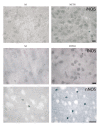Methamphetamine and Parkinson's disease
- PMID: 23476887
- PMCID: PMC3582059
- DOI: 10.1155/2013/308052
Methamphetamine and Parkinson's disease
Abstract
Parkinson's disease (PD) is a neurodegenerative disorder predominantly affecting the elderly. The aetiology of the disease is not known, but age and environmental factors play an important role. Although more than a dozen gene mutations associated with familial forms of Parkinson's disease have been described, fewer than 10% of all cases can be explained by genetic abnormalities. The molecular basis of Parkinson's disease is the loss of dopamine in the basal ganglia (caudate/putamen) due to the degeneration of dopaminergic neurons in the substantia nigra, which leads to the motor impairment characteristic of the disease. Methamphetamine is the second most widely used illicit drug in the world. In rodents, methamphetamine exposure damages dopaminergic neurons in the substantia nigra, resulting in a significant loss of dopamine in the striatum. Biochemical and neuroimaging studies in human methamphetamine users have shown decreased levels of dopamine and dopamine transporter as well as prominent microglial activation in the striatum and other areas of the brain, changes similar to those observed in PD patients. Consistent with these similarities, recent epidemiological studies have shown that methamphetamine users are almost twice as likely as non-users to develop PD, despite the fact that methamphetamine abuse and PD have distinct symptomatic profiles.
Figures





References
-
- Thomas B, Beal MF. Parkinson's disease. Human Molecular Genetics. 2007;16(2):R183–R194. - PubMed
-
- UNODC. E. 12.XI. 1. United Nations publication; 2012. World drug report.
-
- McCann UD, Kuwabara H, Kumar A, et al. Persistent cognitive and dopamine transporter deficits in abstinent methamphetamine users. Synapse. 2008;62(2):91–100. - PubMed
-
- Ares-Santos S, Granado N, Oliva Dopamine D1 receptor deletion strongly reduces neurotoxic effects of methamphetamine. Neurological Diseases. 2012;45:810–820. - PubMed
LinkOut - more resources
Full Text Sources
Other Literature Sources

